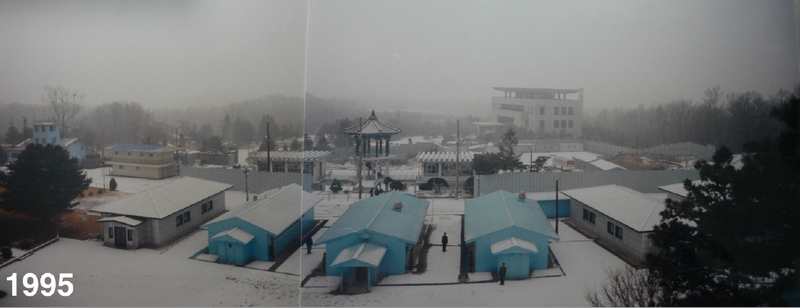How things have changed (and not) at Panmunjom in North Korea over the years
Before & After:
Panmunjom, North Korea
Before & After is a Koryo Tours blog series looking back through our vast archive of photos taken on the thousands of tours to North Korea we have operated since 1993.
Observing changes in North Korea (and the lack of them in some cases) over the years in various areas and over various time scales.
PANMUNJOM
One of the most famous places in all of the DPRK and a site visited by almost every visitor to the country.
Panmunjom is the ‘Truce Village’ that sits on the DMZ, the line that separates North Korea from South Korea, and has done since the signing of the Korean War Armistice on July 27th, 1953.
This is a date marked as ‘Victory Day’ since then in North Korea.
Visiting Panmunjom in North Korea
A 3-hour drive from Pyongyang brings visitors to the North to this highly militarised (despite its name, the DMZ means ’Demilitarized Zone’) area where each group is accompanied by Korean People’s Army officers as you enter the 4km-wide DMZ.
First a souvenir shop and lecture on how this site became how it is (heavy on the political and historical line followed in the DPRK of course), and then a drive to the Armistice Negotiation Hall and the Armistice Signing Hall.
Both of which are on the northern side of the line.
Finally, visitors get as close to South Korea as they can – with a visit to the series of huts that straddle the actual Central Military Demarcation Line.
This is a raised concrete step which runs through Panmunjom and is the de facto border between the two states.
How has this site changed over the years? See below for some examples!
1. The JSA (Joint Security Area)
This is the pace with the huts that sit across the ‘border’, the blue ones administered by the UN (or as they say in North Korea, ‘the US’), and the silver ones being DPRK-run.
Visitors can usually access the central blue hut where strangely if you enter from the south you can’t sit down or touch the furniture, while if you go in from the north you can. Just one of many uncanny experiences in this singular location.


Here we can see how the pavilion behind the row of huts on the South Korean side has changed, with a large looming building (clumsily and unsubtly named ‘Freedom House’) built in 1998. This building featured in global news in April 2018 when Kim Jong Un crossed the DMZ and met with South Korean President Moon Jae In here, and again in June 2019 when it was the site of the bizarre Donald Trump/Kim Jong Un/Moon Jae In summit which featured Trump stepping over the concrete step at the urging of Kim. Incredible scenes for sure.
2. Military Guides
Every tour group, whether made up of one person or a larger group, is accompanied here by a KPA military officer and a couple of soldiers (for your protection of course!).
These officers can be tough, but also have a good sense of humour. Mostly though they will give you the DPRK version of events that led to this tragic division, as well as some statements about the inevitability of unification coming in the future.
Visitors usually find them more than willing to answer questions, pose for photos, etc.
Their uniforms haven’t changed in a long time though even though the regular KPA soldiers' outfits were updated and modernised in 2016, the main guide officers wear the classic green army uniforms. This is a style both retro and timeless at once!

3. Armistice Negotiation Hall
Before one gets to the front line itself this is a stop made to hear all about how the years of negotiations dragged on here as the war raged up and down the peninsular, causing death and destruction beyond measure.
Finally, an agreement was hammered out and papers signed by representatives of the DPRK and the UN (General Nam Il for the Koreans, and General William Henry Harrison on behalf of the UN – with the national leaders signing their own copies later on).
This ended the fighting part of the conflict and was supposed to be a temporary solution rather than a permanent situation. Decades later things are unchanged at this point and the division of Korea looks less and less temporary, deeply tragically for all those affected directly by this cruel division.


More than 60 years later tourists stand in front of the original tables and chairs where the signing ceremony took place.
The DPRK version is that the UN (sorry, ‘the US’) has requested a tent be erected for this ceremony so that no permanent mark would be left to show their shame at bowing down in front of the might of the Korean People’s Army (we paraphrase here, anyone who has been there will recognise this type of rhetoric though) so the KPA quickly erected this building in just a few days and it stands still as a monument to the signing of this historical document.
What is it really like to visit the DMZ
We hope you have enjoyed this look at how things have changed (and not) over the years at Panmunjom.
Look out for more entries in our Before & After series of photos from North Korea!